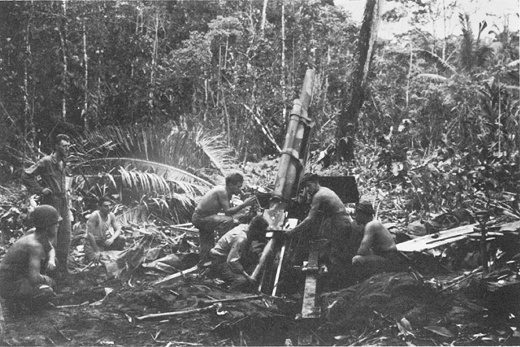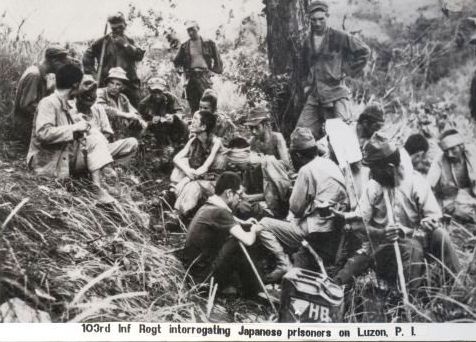

World War II
152nd Field Artillery Battalion, 43rd Infantry Division, Pacific Theater
152nd Field Artillery Battalion, 43rd Infantry Division, Pacific Theater
(c) 152nd Field Artillery Association, 2010
On October 1st, 1942, the 43rd embarked for the
Southwest Pacific theater and landed in New Zealand and
on Espirito Santo Island in the New Hebrides. Members of
the Division's 172nd Infantry Regiment were on the ship
Calvin Coolidge which was sunk in the New Hebrides on
October 26th, and all the Regiment's equipment and
baggage was lost.
The 43rd moved to New Caledonia in November of 1942, and moved again to Guadalcanal in February of 1943. On February 21st, the Division invaded the Russell Islands without enemy resistance. After continued training, elements of the 43rd were organized as a Task Force and made assault landings on Rendova Island. On June 30th, the Division landed on New Georgia Island and fought the Japanese defenders continuously for 81 days accounting for 4,000 enemy dead and also particpating in the capture of the crucial Munda airfield on August 5th, 1943. The Division next participated in the capture of Arundel Island against strong enemy resistance which ended with an enemy withdrawal on September 22nd.
The 43rd moved to New Caledonia in November of 1942, and moved again to Guadalcanal in February of 1943. On February 21st, the Division invaded the Russell Islands without enemy resistance. After continued training, elements of the 43rd were organized as a Task Force and made assault landings on Rendova Island. On June 30th, the Division landed on New Georgia Island and fought the Japanese defenders continuously for 81 days accounting for 4,000 enemy dead and also particpating in the capture of the crucial Munda airfield on August 5th, 1943. The Division next participated in the capture of Arundel Island against strong enemy resistance which ended with an enemy withdrawal on September 22nd.
152nd Field Artillery Association
152nd Field Artillery gun crew in New Georgia, Soloman Islands, 1943
The 43rd was then sent to New Zealand for rest and additional training before moving to Aitape in Northeast New Guinea in July of 1944 in anticipation of a major enemy attack in this area. Captured Japanese documents had revealed that over 30,000 Japanese troops would attack along the Driniumor River Line to allow some 70,000 troops trapped in eastern New Guinea to escape. The fighting along the river line continued 30 days before the Japanese 18th Army was defeated. On August 8th, the Division took the offensive to prevent shattered Japanese elements from regrouping, and all effective resistance was crushed by August 25th.
After another rest and training period, the 43rd was on the attack again as part of Operation Musketeer I and made assault landings on Luzon in the Philippines at beaches in the San Fabian area of the Lingayen Gulf on January 9th, 1945. The mission given to the 43rd was to secure the left flank of the invading force and to prevent the Japanese forces at Baguio from moving south. In this operation, the 43rd was credited with killing more Japanese soldiers than all the other Divisions combined. By February 12th, 1945, the men of the Division had
43rd Infantry Division Association website (link updated 16 Jan 11)
Shortly after the Division moved to Camp Shelby in early 1942, they began the difficult transition from a Square Division, with four Infantry
Regiments each with a Field Artillery Regiment, to a Triangular Division with only three Infantry Regiments each with a Field Artillery
Battalion. The 152nd Field Artillery Regiment was divided up, and the 2nd Battalion was redesignated the 152nd Field Artillery Battalion.
Lieutenant Colonel Norman Whitney, formerly the commander of the 2nd Battalion, became the commander of the new battalion. The
new 152nd was the habitually-supporting artillery for the 103rd Regimental Combat Team, also originally from Maine.
The Division departed Camp Shelby for their Port of Embarkation, Fort Ord, California, arrving on September 10, 1942.
The 43rd Infantry Division: Unit Cohesion and Neuropsychiatric Casualties. Excellent Master's Thesis written in 1999 by K. Graham
Fuschak, Major, U.S. Army. Great for its summary of what llife was like at Camp Blanding and Camp Shelby in 1941-42, for both
battalions, and for its brutally honest study of conditions during combat.
Field Artillery article from August 1994 on artillery operations in the jungle; photo above is taken from this article.
reached the Lingayen Plains and given a brief rest before resuming the attack. On February 27th, the 43rd attacked the Fort Stotsenberg
Area of Luzon, eliminated pockets of resistance in the Zambales Mountains, and then moved southward to crush the Shimbu Line in the
Antipolo-New Bosoboso Sector east of Manila. The Division next spearheaded the assault on Ipo Dam, the main source of water for
Manila, and blasted the Shinsu Fortress surrounding the dam, securing the area on May 19th.
The 43rd continued to mop up enemy remnants until the Japanese surrender. In September the Division embarked for occupation duty north of Tokyo and returned home the following month.
The battles won and the three campaigns fought by the men of the Winged Victory Division had exacted their toll, costing over 6,026 combat casualties in killed and wounded. The men of the 43rd adopted the Division motto while on Luzon in honor of their Commanding Officer, Major General Leonard Wing, the only National Guard officer in WW II to be promoted to command an active combat Division.
The 43rd continued to mop up enemy remnants until the Japanese surrender. In September the Division embarked for occupation duty north of Tokyo and returned home the following month.
The battles won and the three campaigns fought by the men of the Winged Victory Division had exacted their toll, costing over 6,026 combat casualties in killed and wounded. The men of the 43rd adopted the Division motto while on Luzon in honor of their Commanding Officer, Major General Leonard Wing, the only National Guard officer in WW II to be promoted to command an active combat Division.
History of the 43rd Infantry Division Artillery 1941-1945 by Harold R. Barker tells the tale of the 152nd FA and the rest of the
Divarty in the Pacific Theater, and is a gold mine for anyone interested in serious research of the battalion. The entire .pdf file, all
82MB, is available to download here. **New** A smaller (17MB) version without photos and maps is here. Click here for a by-name
index of names found in the book (over 800 names).
152nd FA Operations Journals - Aitape (2MB) and Luzon (7MB). These journals were copied from the originals stored at the National
Archives by Hale Bradt, son of 152nd FA Commander Wilber Bradt. Hale had them scanned at his own expense and passed them along
to us. These journals are a priceless, up-close, detailed accounting of the battalion's actions during these campaigns.
Historical Report, Luzon Campaign, 43rd Infantry Division (1945). This is a scan of LTC Wilber Bradt's personal copy of the official
Division report (20MB), annotated by him throughout. LTC Bradt commanded the 152nd during this campaign. Provided courtesy of Hale
Bradt.
152nd FA Historical Reports - These are scans of the actual reports submitted by the battalion (18MB) regularly throughout the war,
beginning in July 1943 (including the New Georgia campaign) through the end of the war. Provided courtesy of Hale Bradt.
1942 43rd Infantry Division Camp Shelby Yearbook extract, only the 26 pages covering the 152nd Field Artillery (7MB).
This book was probably published in mid-1942, so it should include just about everyone that shipped overseas that October.








